Ethnographic Park in Tokarnia
Provincial sector
MONASTERY GRANARY FROM CHĘCINY
The wooden, multi-storey granary was built in the mid-18th century. Originally, it was a part of the farm buildings belonging to the Monastery of the Poor Clares in Chęciny. In 1930, the monastery complex became the property of the Bernardine Sisters. This congregation was the last private owner of the granary. It performed an economic functions until World War II. The granary building was built of wooden beams in a log frame construction and was covered by a hipped roof which, according to sources, was covered partly with thatched roofs and partly with shingle in the XIX century. The wooden gallery in front of the building, accessed by external stairs, made its very stylish. An eighteenth-century anonymous carpenter - granary builder - using a relatively simple construction procedure with decorative struts, obtained a ornamental semi-circular shape of the door openings. The monastery granary from Chęciny is currently a rare example of this type of farm buildings in the region of Kielce. The building was bought by the museum in 1982. It is located at the very entrance to the museum and is adapted for the checkout, tourist information and the point of sale of publications.
COTTAGE FROM SIEKIERNA
The cottage from Siekierno (Bodzentyn commune) was built by an anonymous carpenter in 1887. This is confirmed by the inscription and date carved out on the central beam supporting the ceiling in the room. The house was bought from Henryk Brzeziński and moved to the museum from the village of Siekierno, located in the picturesque Świętokrzyskie Mountains. The walls of the originally two-bay cottage were made of fir logs, on a nearly square plan. The layout of the living rooms was as follows: in the communication route starting from the front there were a hall and a room, while in the back - a small alcove with a kitchen and a chamber. The cottage had two-part, six-pane windows surrounded by profiled straps made of boards. Inside the building you can find a traditional oven connected to the chimney and the niche in the hall. Currently, the building has been temporarily adapted to function of an "inn" in the museum.
GRANARY FROM WYSZMONTÓW
The wooden granary from Wyszmontów is an example of an 18th-century farm building. It was originally built in Zawichost upon Wisła. It was pulled down in the nineteenth century, and moved to Wyszmontów, (the Ożarów commune), where, in addition to the manor, together with the distillery, it was part of a complex of court buildings belonging to the last owners of Wyszmontów - the Załęski family.
The building has two floors with an usable attic and was built of larch and oak wood. The walls are made of beams attached to a double-sided overlay with remnants (remnants are the beams, protruding beyond the building outline). Four huge doors made of oak were hung on forged belt hinges. Slotted windows were covered by decorative, forged iron bars. In the front of the building there is a balcony, stretched between two outbuildings and a eight pillars, supporting the roof structure.
The granary with a hip roof covered with a double shingle is intended for permanent exhibitions dedicated to the culture and folk art of the Kielce region.
HOUSE FROM SKORZÓW
The house from Skorzów was built at the end of the 19th century. Its founders were Andrzej (1857-1923) and Jadwiga Lasia, rich farmers, owners of a nearly 20 hectares farm. The walls of the building are made of wood building were build from beams laid horizontally and attached to vertical poles. The walls are covered formwork from boards, giving them a representative character. The cottage has an entrance from the front (wide-front cottage), with a decorative porch, which is embellished by wooden slat with intricately cut edges and large ogival windows. The building is covered with a gable roof with an original red ceramic tiles. Noteworthy are also the tiled stoves in the rooms and rich kitchen equipment, as well as the varied walls colors in the rooms.
Inside the cottage there is an exhibition presenting the interior of the home of doctor Witold Poziomski, a doctor working in Suchedniów, a small town located about 25 km north-east of Kielce. The preserved layout of the rooms with two corridors characteristic for two-bay buildings, allowed to arrange the waiting room, doctor's office, bedroom, living room and kitchen. They were equipped with original equipment from before World War II, originating, among others, from the doctor Poziomski's apartment. The exhibition includes many items illustrating the process of popularizing an electricity, which in this period became something necessary in the work of a medic. In Suchedniów, where doctor Poziomski was from, in the 1930s electricity was supplied to many buildings. That is why the exhibition includes luxury devices such as a vacuum cleaner, radio receiver and telephone set. The walls in the kitchen were painted using the pre-war paint rollers made of rubber, which give a fashionable pattern on the wall in the 1930s. It is worth paying attention to interesting furniture from that period: the original cutlery storage cabinet brand of Gerlach, wheeled bar, as well as a dresser with a porcelain service, finished by silver. According to the fashion of those times, the main table was set up in the middle of a representative living room. In the doctor's office you can see the pre-war exposure camera set on the couch - a rare exhibition, one of the most interesting of its kind in Poland. Next to is a portable sink, activated by pressing a special pedal and an original old gynecological chair, indispensable in medical practice.
In 1918-1939, there were no permanent doctors' offices in many small towns of Kielce area. Emergeny assistance was sometimes provided by Pharmacists, which were also prescribing appropriate medications.
Doctor Witold Poziomski was a non-standard person, full of sense of humor, who professionally served the Suchedniów community for over 40 years.
The organist's house from Bieliny
The organist's house from Bieliny located in the Świętokrzyskie Mountains was probably built in the mid-nineteenth century. The museum bought the building from Wacław Kolasa. The wooden building was built in a way preventing the walls decorated with wooden boards move apart. The building is covered with a pediment roof covered with shingles. Inside the house there are rooms in a two-bay system with hall. In each room, there is a furnace connected to the centrally located special type of chimney.
Regarding the architecture, two porches attract attention, with tops decorated with wooden slats, lattices and silhouettes of birds. Inside the building there is an exhibition presenting a small-town 19th-century pharmacy and interiors inhabited by well-known pharmacy family Górbielów from Suchedniów.
In two rooms of the building an expedition room and a pharmacy laboratory were arranged . Pharmacy furniture (repositoria) in which medicines were stored come from a pharmacy in Busko Zdrój that no longer exists. On the shelves there are glass flasks and jars, porcelain containers, siphons, metal and wooden cans for herbs and minerals. The bottles in which narcotic drugs were stored - "Narcotica" - were marked with black labels with a red border and a white inscription. The poison containers - "Venena" or "Tabula A" - had black labels with white inscriptions. Drugs with a strong effect, from the group "Tabula B", were marked with white labels with a border and an inscription in red. The most numerous group of drugs were those with a weak effect, from the group "Tabula C". They were stored in containers with white labels, with a border and black inscription. The pharmacy also has cardboard and glass packaging for medicines, food and cosmetics such as soaps, creams for pinking the cheeks, tooth powders, medicinal wines, mustards, refreshing vodkas and others.
The presence of siphons and glass bottles reminds that lemonades and mineral waters ware widely sold by pharmacies. In the expedition room there is a table (so-called menza), used to dispense medicine. On this table was placed a scale, a container for leeches and a desktop with a book for entering the issed prescriptions. Original prescription flags, lithographed, from the pharmacy in Oksa, photocopies of flags and signatures in the shape of envelopes from the Saski pharmacy in Kielce, as well as various labels from the pharmacy in Busko were presented.
n the small room some devices and exhibits which can be found in the galenic laboratory were shown. A pharmacist's workplace was arranged next to the window - there are pharmacopoeias on the table (official lists of authorized medicines), pharmacy fees, writing utensils, laboratory scales, microscope, burets. Next to it there are numerous mortars - in various shapes, made of various materials. Undoubtedly, a unique exhibit is the original eighteenth-century device for "pouring" wax candles. Noteworthy are the 19th century glass retorts, hand-held pill press, suppository making machine, various types of glass funnels, pitchers, press for squeezing fruit juice for liqueurs and extracts. There is also a small educational herb garden in front of the pharmacy.
HENHOUSE FROM BIELINY
Henhouse from Bieliny represents a type of small, wooden farm building coming from the Świętokrzyskie Mountains. The building was built in 1895. and originally was a part of the farm of rural organist. Regarding the architecture, the decorative triangular cut-out shingles at the edge of the eaves are noteworthy, as well as the harmonious proportions of walls and the hip roof. The henhouse, according to its original location, was placed in the vicinity of the organist house from Bieliny.
COTTAGE FROM SZYDŁÓW
The cottage from Szydłów was built in 1705, as it stay in the inscription cut out on the central beam supporting the ceiling in the room. Currently, it is the oldest, known to us, example of this type of folk architecture in the Kielce region. The object was bought from Janina Gardyńska. The wide-front cottage (with an entrance from the front) and one communication route (single-route) was built on a rectangular plan. The building consists of four rooms: a hall, a room and a chamber and a barn which was added later. The walls are made of hewn beams, covered with a thatched hip roof. Inside the building things that deserves attention are doors, mounted on a primitive "turnstile", leading to the hallway and utility rooms, as well as the way the floor is made: "beaten" with wooden pegs, made of hewn boards. Besides noteworthy is the archaic in the form and technical solutions kitchen oven. Inside the cottage there is a permanent exhibition illustrating the living conditions of a poor Jewish tailor's family. In the room furnished with exhibits from the 1920s and 1930s, you can see a modest pre-war tailor workshop with a sewing machine, screen, ready-made clothes, and a set of sewing accessories and equipment - including irons. The interior design, through the use of religious accessories and "Judaicas," reflects well the mood of preparation for the Sabbath supper. On the table there are holy prayer books and ready-to-eat ritual bread - "Challah". In the hall there are suitcases, as a sign of door-to-door trading cultivated by residents - an activity characteristic of a significant part of the poor Jewish population. Judaic religious accents inside the house are: mizrah - a plate with an inscription in Hebrew, attached to the eastern wall of the room, kiddush cups on a sideboard and two trays with engraved symbol of the Star of David and Hebrew inscriptions.
HOUSE FROM WĄCHOCK. SMALL-TOWN STORE
A residential house with a central hall was built in 1863 by the Grzybowski family. The building formely stood in Wąchock at Starachowicka Street, where the oldest and most interesting monuments of small-town architecture survived until the 20th century.
The two-bay, wide-front building was built on a stone foundation. The walls are made of pine beams wedged on a double-sided overlay, retaining protruding "remnants". The building is covered with a hip roof with a double layer of cracked shingle. A typical feature of wooden buildings of the old, nineteenth-century Wąchock, was the central, cobbled hallway with an open (no ceiling) entrance to the attic. This is the type of house transferred to the museum.
Interesting elements inside the building are panel doors as well as double-leaf windows. The house consists of: on the right side of the hall - a large room, then a small kitchen, on the left a living room and a chamber.
The house is hosting an exhibition showing a small-town shop from the 1930s. It was arranged using original store furniture. A set of pre-war bottles, jars and other packaging were exposed on shelves and display cases. Above the entrance hangs an old commercial sign: 'POLISH GROCERY. WŁADYSŁAW KORNECKI ”, originating from Końskie. The store offered a wide range of goods, from cosmetics and chemical products, through tobacco, alcohol, beer, to food, meats and confectionery. The most interesting exhibits include the HABERBUSCH brewery fridge, ice cream maker, kerosene distributor and paper accessories collection.
In the second of the store's premises, there is a sparkling water plant. On the opposite side of the hall the interiors inhabited by the shopkeeper's family were recreated.
HOUSE FROM WĄCHOCK. PROVINCIAL PHOTO ATELIER FROM INTERWAR PERIOD
The house was built around 1870 in Wąchock at Starachowicka Street. It was part of a multi-building homestead belonging to the Bzinkowski family. It is a wide-front building (with an entrance from the front), with a central hallway and two internal passageways. The walls were made in a log construction, connecting beams in the corners on the so-called two-sided oblique overlay with protruding "remnants". The hip roof has a double layer of shingle. One of the characteristic features of the cottage is a cobbled walkway, to which there are two-wing gates made of planks. The windows in the front facade are secured with wooden shutters. The kitchen and adjacent room have kitchen stoves with heaters and a bread oven. In the second room, a tiled stove was recreated - this variety shows the changes that have taken place in devices of this type installed in residential interiors. The spacious rooms of the cottage hosted an exhibition that shows how the small-town photo studio from the interwar period looked like, as well as the residential interiors of the photographer. Attention is primarily drawn to the atelier, which is equipped with a studio bellows camera on a wooden tripod, a photographic screen used as the background for the photographed person, a rotary stool, a retouching desk, and many others photographic accessories. A set of valuable batik furniture from the interwar period was used to furnish the room. The interior design of the studio is complemented by numerous photographs from before 1939. At the studio there is a small room, which serves as a darkroom, in which equipment for developing photographs has been collected: an enlarger, a copier, a darkroom clock, cuvettes, a scale and laboratory vessels for chemical reagents.
HOUSE FROM ĆMIELÓW
The house comes from the small town and is one of the most beautiful architectural objects in the museum. It is distinguished by a characteristic half-gable roof and an entrance with a semicircular lintel and decorative profiled struts (elements connecting the pole with the beam lying on it). The house was built in 1800 (date on the beam) by Jan Wójcik. It is a two-bay, wide-front building. It consists of a hall, large room, small room and chamber. The whitewashed walls are made of hewn and hewed beams with remnants. In the large room, there is a huge beam of larch wood, called "siestrzan", supporting the ceiling beams. The hall has been preserved clay floor, as well as tiled kitchen stoves with heaters. Restored here residential interiors from the interwar period were used by large provincional families, mainly living from agriculture. The chest, where the most valuable clothing was stored, was replaced by a simple chest of drawers, on which objects of worship were placed, forming the so-called "Sacred corner". In the sideboard there are factory dishes made of porcelain and glass, which in Ćmielów displaced glazed clay pots relatively early.
COTTAGE FROM DALESZYCE
The cottage from Daleszyce was built in 1892 by Franciszek Malarecki, who at that time owned 9 areas of land. In the open-air museum it forms a part of the frontage of the small town market square. It is a narrow-front building (entrance in the gable wall), one-bay, with the layout of the rooms: hall - chamber - cowshed. The walls of the cottage were made of pine wood. The three-slope roof was covered with a double layer of aspen shingle, it has a boarded gable from the yard side. Entrance to the homestead leads through the gate with a characteristic shingle roof. A summer kitchen was located in the hall with an additional exit to the yard. The main furnace - the one located in the room - was built of broken stone and bricks connected with clay. On the central beam in the living room, the date of construction of the cottage and the "IHS" sign were cut out. The inscription was an indicator of faith and was to ensure God's protection to the inhabitants of the household. A provincional shoemaker's workshop was recreated in the chamber. Among the shoes to be repaired in the workshop you can see chisels and shoemaking knives, "rasps", soles, hooves, awls, "Boards", pliers and hammers. A small barn was placed under the common roof with the cottage. In Daleszyce, shoemaker traditions reached back to the 16th century. Shoemaking was an additional gainful occupation for many farmers who supported their families mainly by working on small lands and on poor farms.
BELL TOWER FROM KAZIMIERZA WIELKA
Right next to the church from Rogów, there is a wooden belfry from Kazimierza Wielka. This two-storey building, with frame construction and walls planked with vertical boards, is located in the line of the church fence, planned for restoration in the future. The building is covered with a hip roof, covered with shingles. The roof has two pairs of opposite surfaces, one pair of slopes has the shape of a trapezoid, the other - a triangle. Built in 1848, the belfry was taken over from the Kazimierz parish dedicated to the Exaltation of the Holy Cross. The museum did not obtained three original bells which were hanging on it (weighing 420, 220 and 100 kilograms, respectively). In 2008, thanks to the funds obtained from the 2008 Patronage Program, the iconographic copy of the most valuable bell from Kazimierz, dated 1776, was made by the Felczyński bell house from Taciszów.
HOSPITAL CHURCH FROM ROGÓW
The wooden church from Rogów is a gift of the Diocesan Curia in Kielce. It was moved to the museum in 1996. Comprehensive restoration work on it was completed in 2002. The Hospital of the Mother of God of Consolation was founded in Rogów in 1763 from the foundation of Michał Wodzicki, the landord of Rogów, the Grand Chancellor of the Crown and the Przemyśl bishop. The temple walls were made of larch wood on oak foundations. The rafter-purlin roof is covered with shingles (rafters are oblique elements of the roof structure, purlins - horizontal beams based on gable walls). Rococo furnishings come mainly from the 18th century. The beam with the foundation inscription and date was made of one piece of larch wood. In the central part hangs a baroque cross with the figure of Christ. Attention is also drawn to the richly decorated pulpit and the original Rococo side altars. In the left one there used to be an oil painting of St. John of Nepomuk (stolen before moving the church), and on the right one there is a picture of the Crucifixion scene. The main altar presents of Madonna and Child from the second half of the XVIII century. According to studies discussing the sanctuaries in the Kielce region, this image was considered as miraculous. In the 18th century, it was covered with a latch with the image of Saint Nicholas. A valuable painted confessional was placed at the entrance to the choir. Noteworthy are rich polychromes with strong folk accents, representative of the Baroque from Małopolska region. The ceiling of the nave is decorated with a painting depicting the fight of Archangel Michael with Satan, the scene of the coronation of the Virgin Mary was presented in the presbytery. The paintings of the church from Rogów were restored in 1864, during the renovation of the temple, by the painter from Wiślica, Rudolf Marusieński - who for years was considered their author. In the museum, the church still performs its original functions - it is an active sacred object, masses are regularly held here.
RECTORY FROM GOŹLICE
The rectory was built in 1768 in the village of Goźlice (Klimontów commune), at the expense of the landlord of Ossolin and Goźlice, and also the local rector - Jerzy Dobrzański. In the years 1957-1976 it served as a catechetical point and later as a grain warehouse. A one-story, two-bay rectory building with walls made of square timber cut into the "overlay" was built on a rectangular plan. The front facade of the building is decorated with a centrally located, baroque entrance portal, obscured by a porch. Details of the portal and the ornament used in it were probably modeled on a similar solution visible in the interior of the parish church in Goźlice. The hip roof is double-shingled. The rectory building from Goźlice is the only eighteenth-century wooden rectory preserved in the Kielce region. Through references to the courtly style it is one of valuable examples of this type of architecture.
RECTOR BARN FROM SUCHEDNIÓW
Wooden barn from Suchedniów was built in 1863. It is covered with shingles, with a large, centrally located "playground" and two zones. Inside the barn there was also a granary for grain with a separate entrance from the front. Noteworthy are the old, nineteenth-century stave doors, decorated with blacksmith's nails. The barn was moved to the museum in 1984. Currently, it serves as a warehouse where antique agricultural machinery and tools are stored. Some of them: threshers of different types, reapers, seeders and forage harvesters are presented during outdoor events under the open sky.
MANORIAL THRESHING HOUSE FROM OGONOWICE
The threshing house was reconstructed in court barn. The building has two bays (a place to place sheaves or hay) and a playground (flat space in the middle of the barn), it is covered with a gable shingle roof. Threshing equipment comes from 1880. Originally they were mounted inside a thatched roof and built of larch beams in a skeleton barn, which belonged to the court farm purchased in the 1890s by the peasant Franciszek Szymański from Makarewicz. The lower part of the thresher was divided into small rooms for storing threshed grain and chaff. The upper beams were fitted with a floor made of thick boards connected "with a groove". At the top there is the threshing mechanism itself and the forage harvester, which could be connected to transmission by transmission belts. In the future, the Museum plans to assemble these devices.

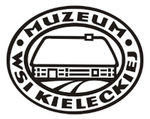
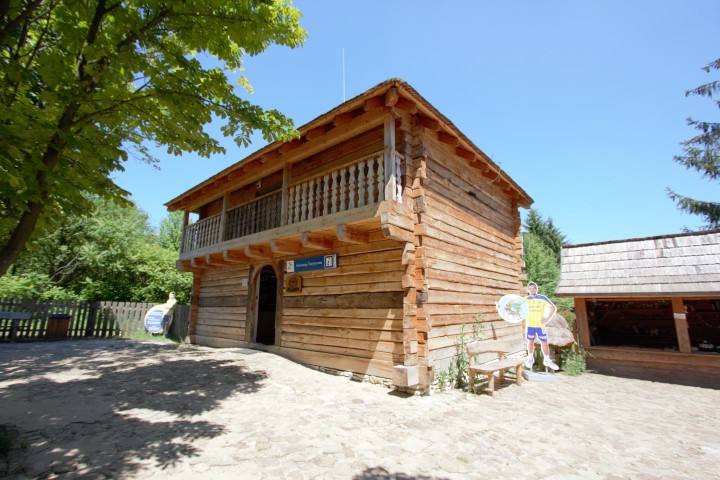

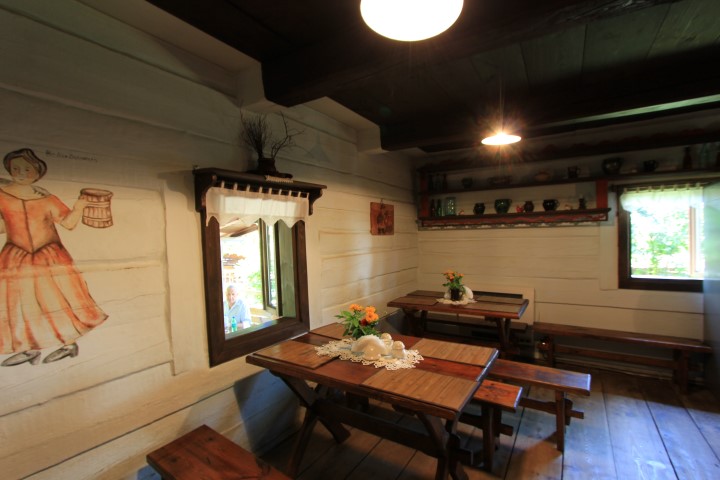
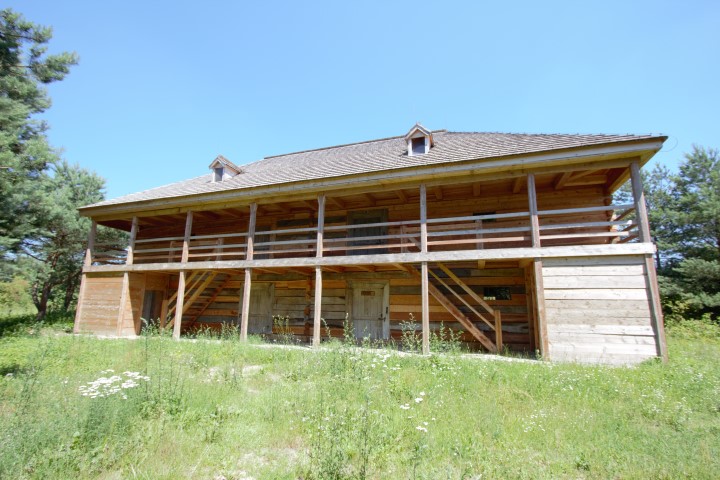
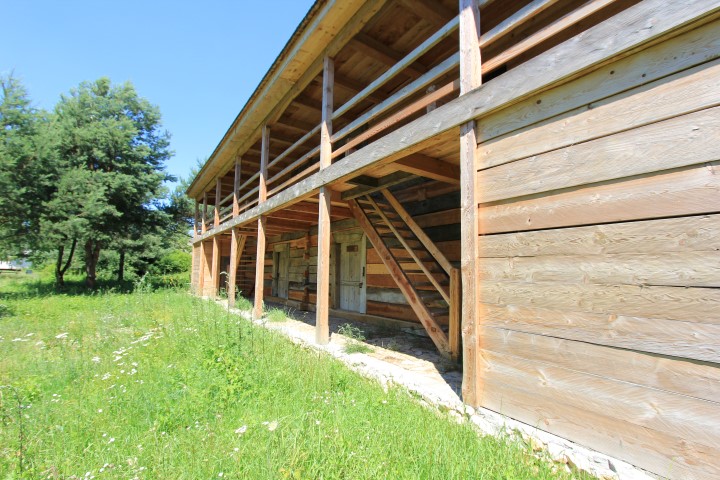
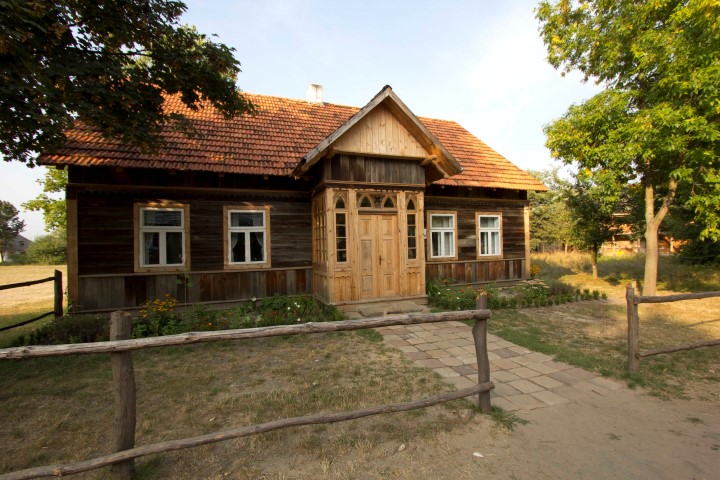
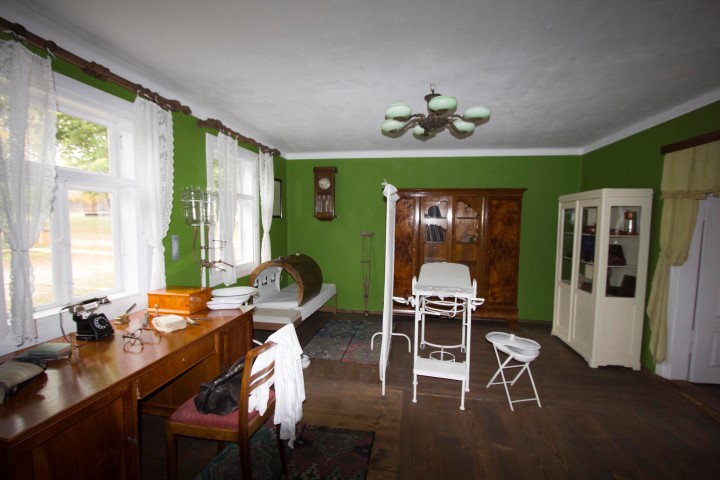
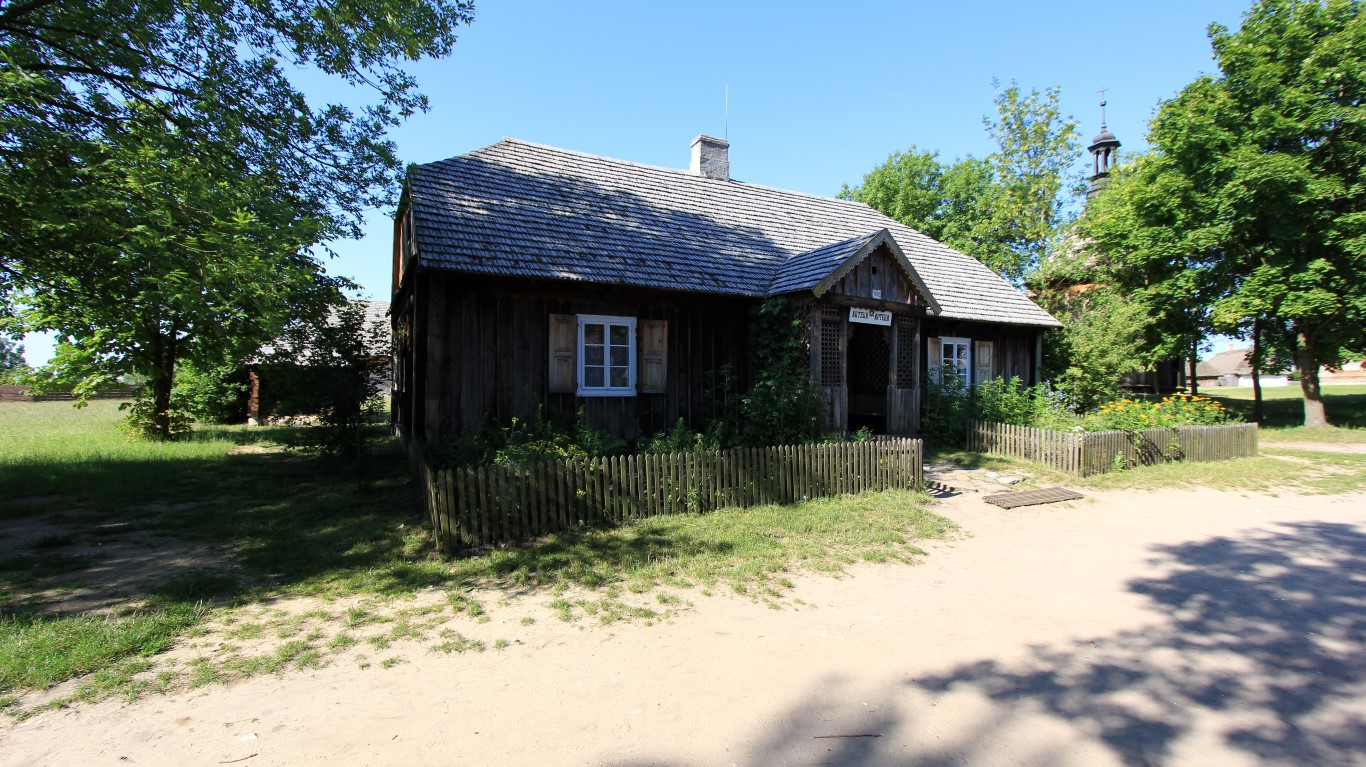
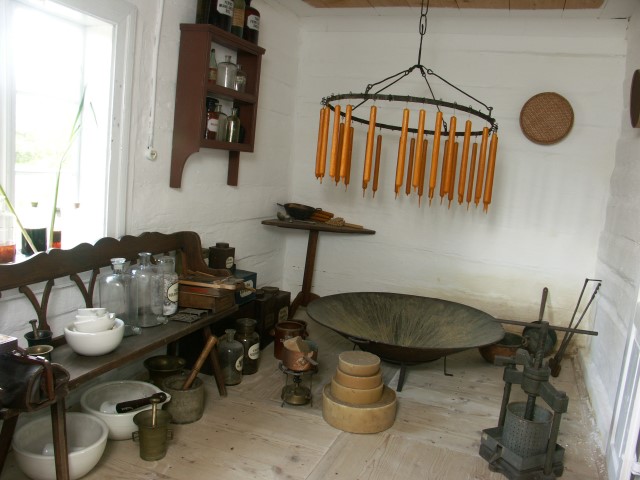
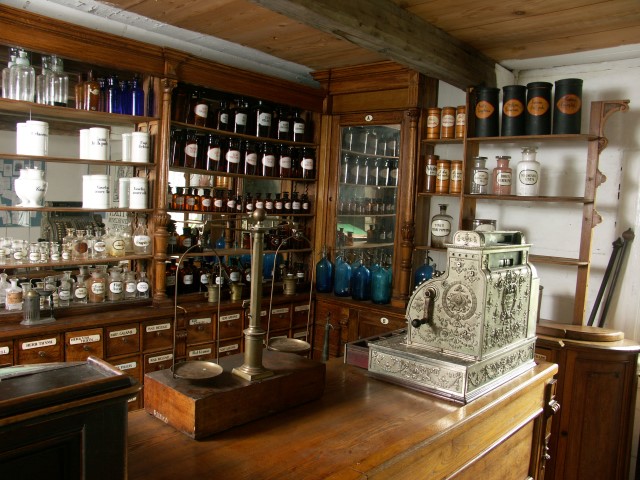
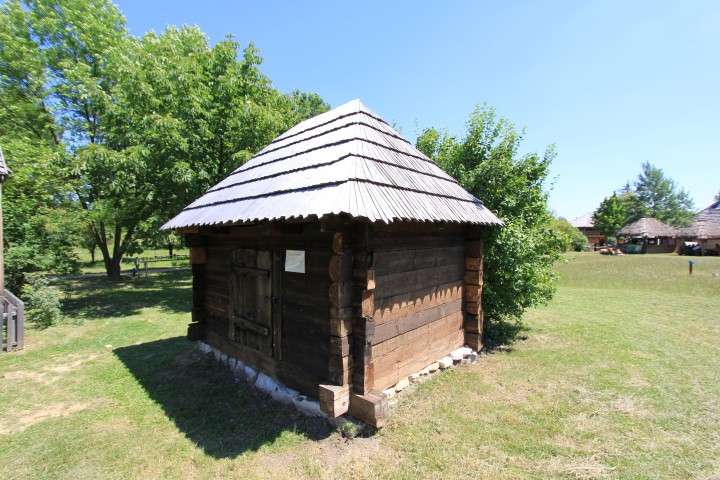
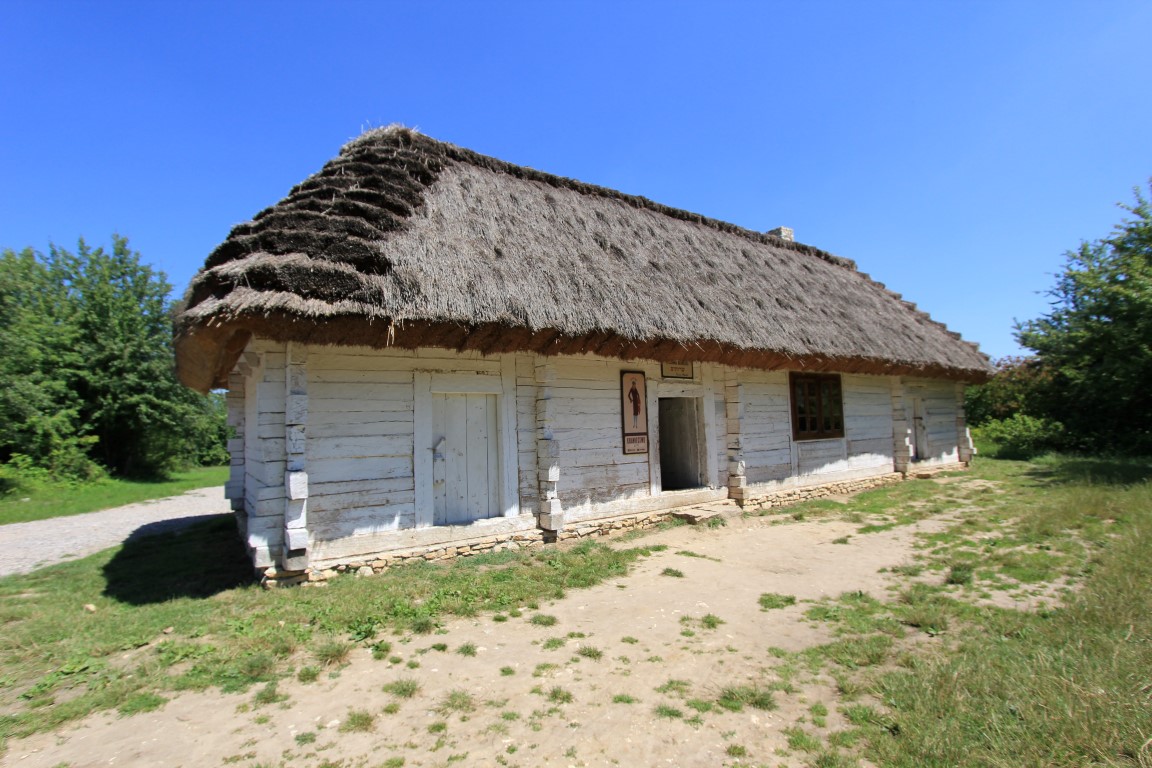
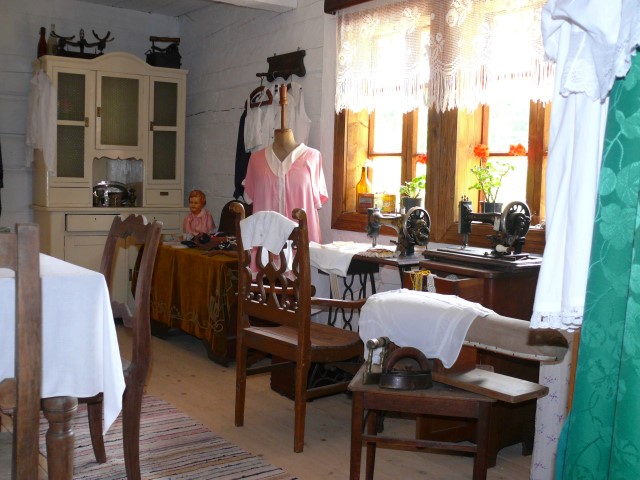
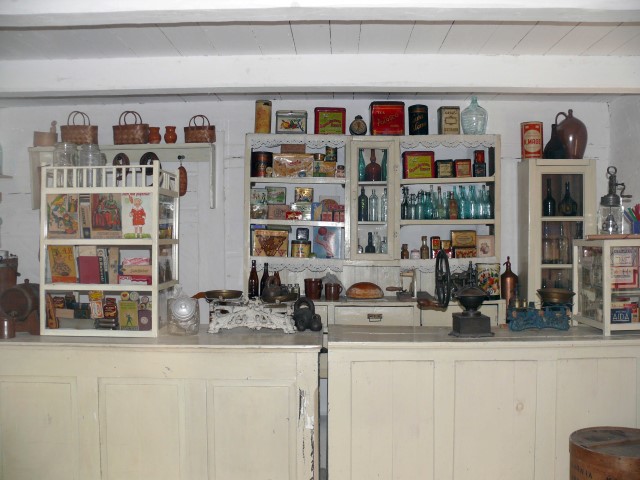
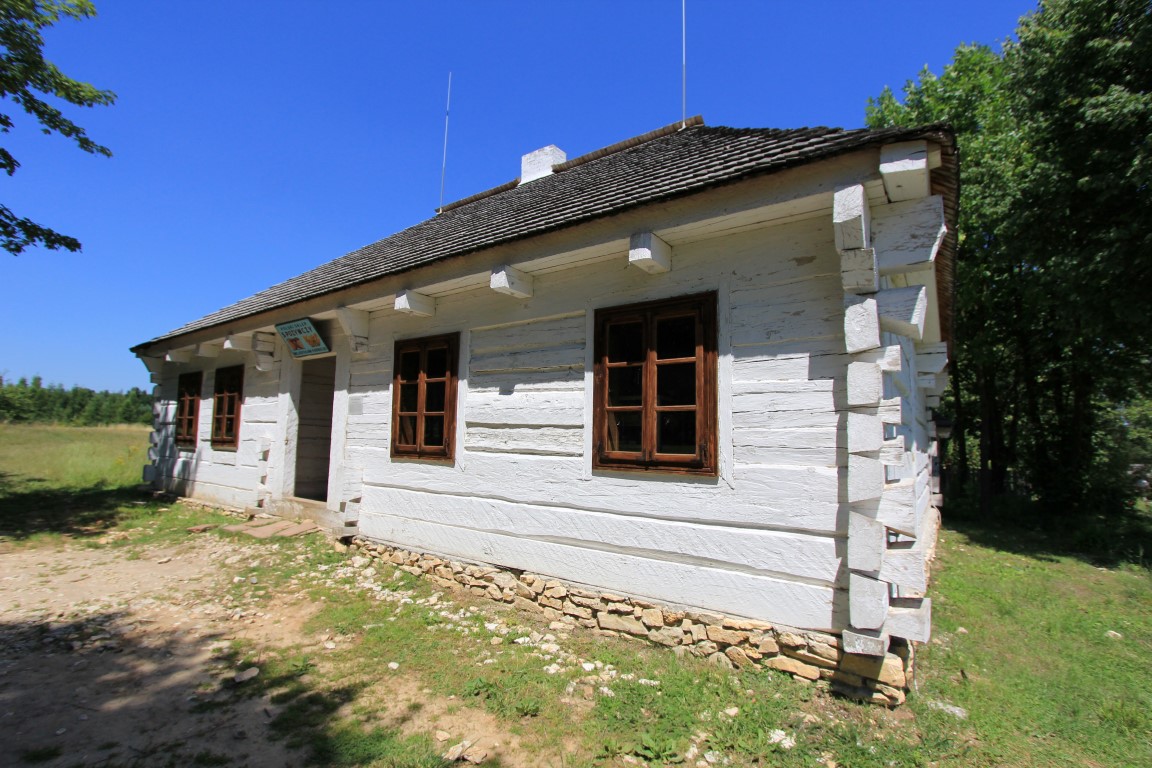
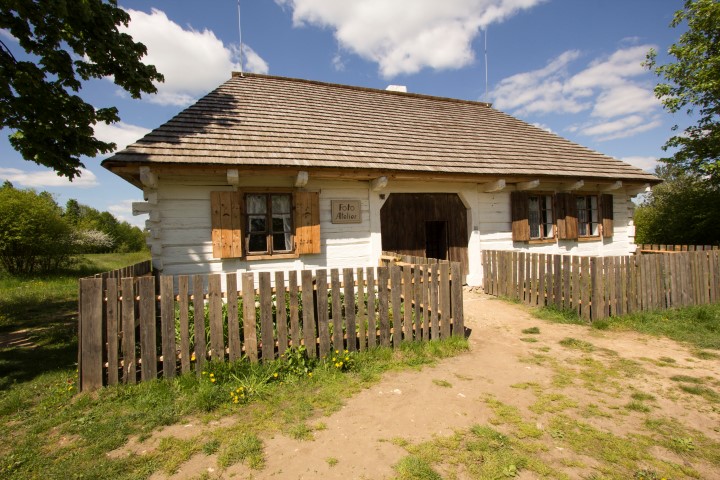

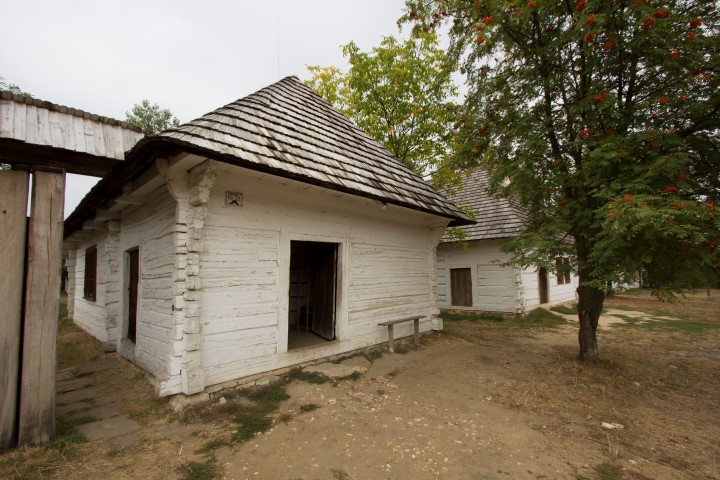
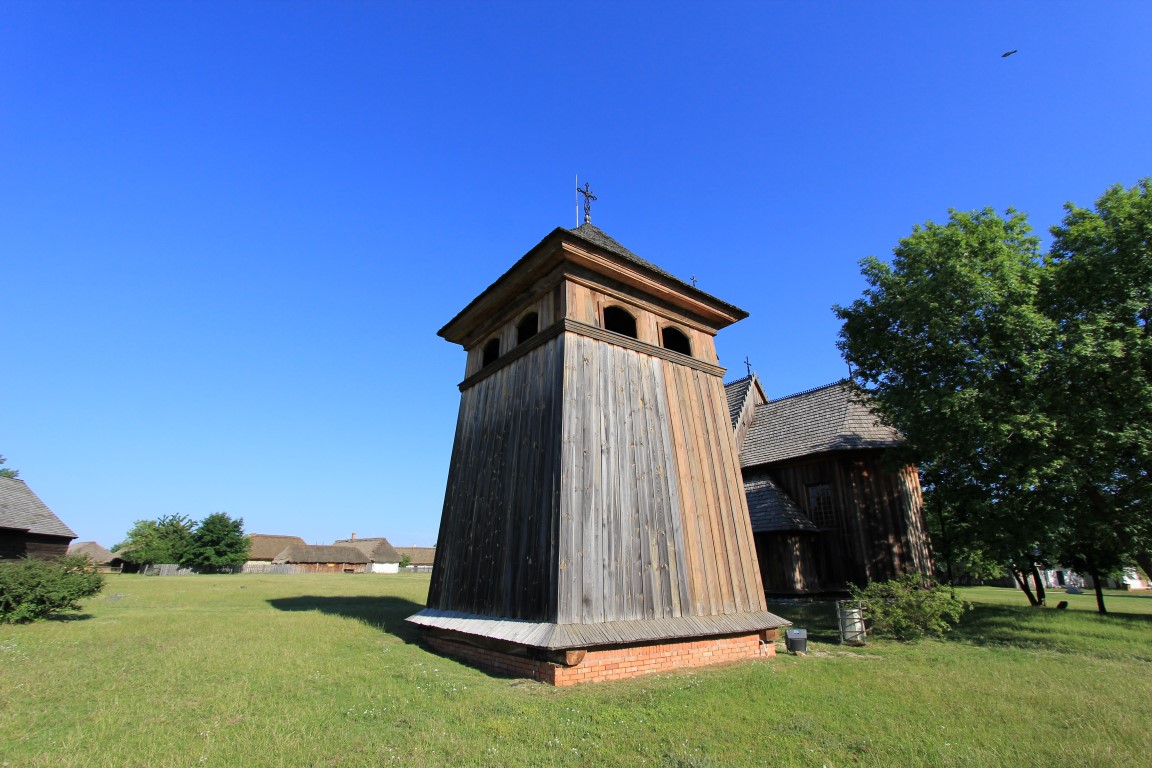
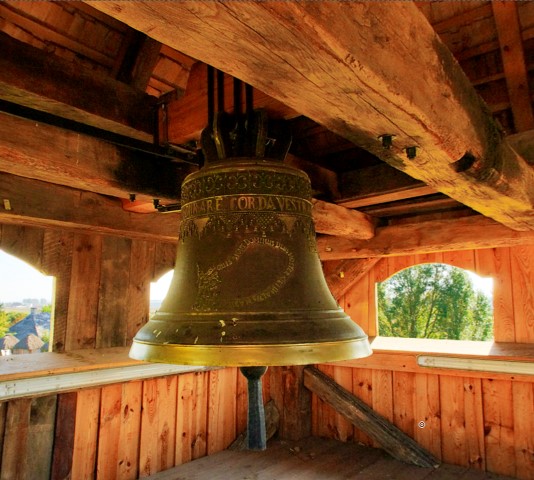
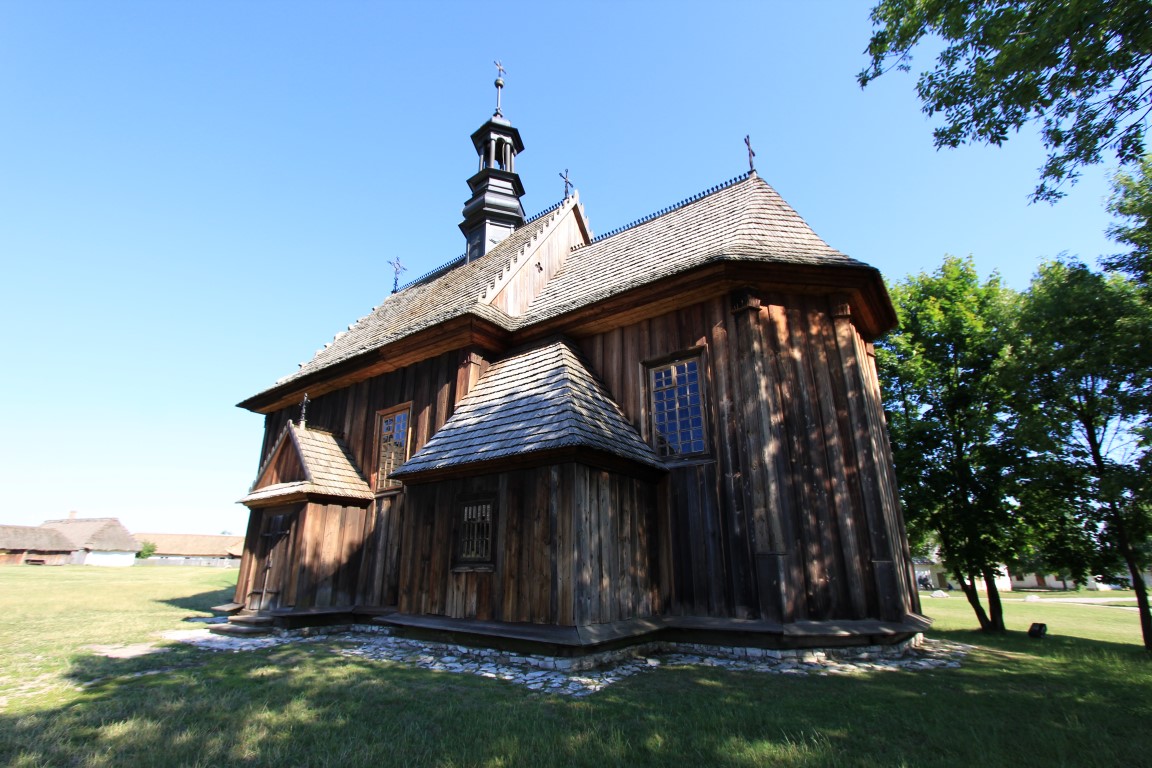
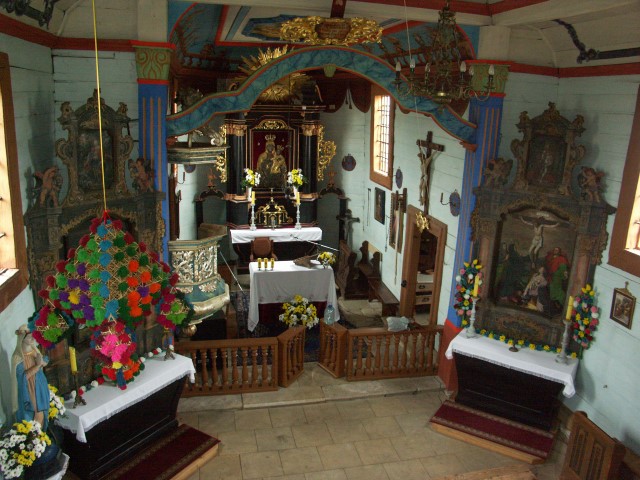

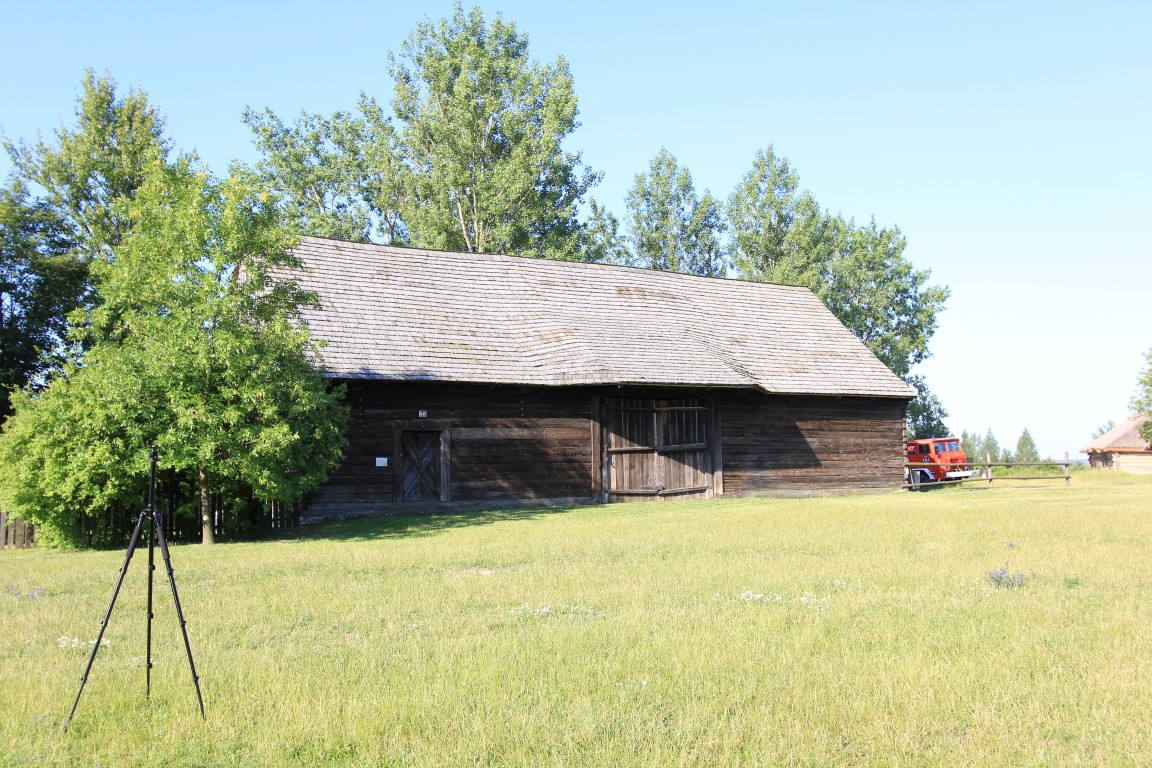
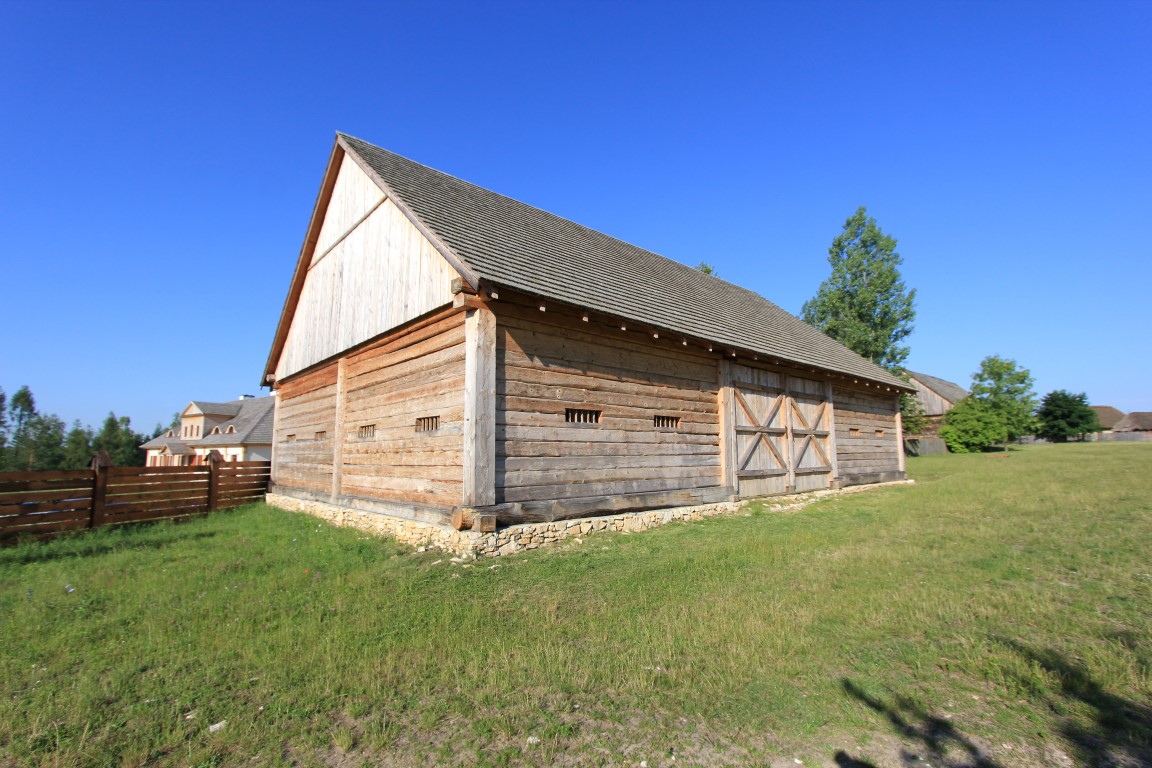
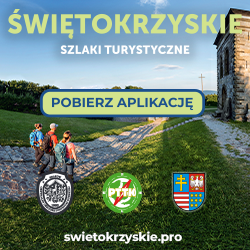
 Zakup współfinansowany ze środków Unii Europejskiej w ramach Europejskiego Funduszu Rozwoju Regionalnego na lata 2014 – 2020
Zakup współfinansowany ze środków Unii Europejskiej w ramach Europejskiego Funduszu Rozwoju Regionalnego na lata 2014 – 2020